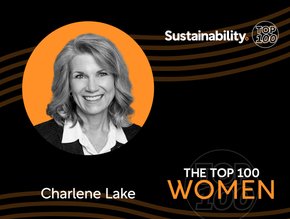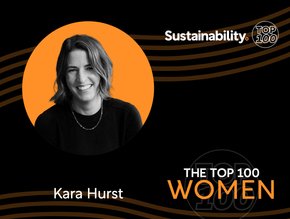How much water do you wear, asks GAP

Do you ever feel like you’re swimming in clothes? Well, the reality could be more literal than you think.
Waste from fast fashion is hurting the planet - the UK’s fast-fashion habit sends 10,000 items of clothing to landfill every five minutes. This equates to £140mn of product every year.
But it’s not just the end of clothing’s life that is having a damaging effect on the environment.
As 10,000 litres of water are used to produce just one kilogram of cotton, the manufacturing of clothes is also having an impact.
Fashion is responsible for 10% of all greenhouse gas emissions, while aviation sits at 2%, something discussed at COP26. Earlier this week, designers such as Burberry and Stella McCartney gathered at the GREAT Fashion for Climate Action, to discuss accelerating sustainable practices in fashion.
Now, new research from GAP reveals the true extent of fast fashion and how our clothing consumption has opened the floodgates to climate change, contributing to contamination and environmental damage.
How wet is your wardrobe?
Open your wardrobe and take a good look. How many pairs of jeans do you have? Hoodies and t-shirts? Open your drawers — what about your socks, underwear, and bras? You always have more than you think; your wardrobe is bursting at the seams.
But do you know how much water it took to produce all those items? As it turns out, a lot. The study from GAP reveals that it takes:
- 7,250 litres of water to produce one pair of jeans
- 3,350 litres of water to produce one hoodie or sweatshirt
- 1,500 litres of water to produce one shirt
- 850 litres of water to produce one pair of pants or boxers
- 550 litres of water to produce one bra
- 375 litres of water to produce one pair of socks
If you think that’s a big splash, get ready for a tsunami.
When we take a look at the average size of a UK wardrobe, our water consumption really adds up. The average person in the UK has 5 pairs of jeans, 7 hoodies or sweatshirts, and 10 t-shirts or shirts. Plus, our drawers are packed with 34 pairs of underwear, 22 bras, and 22 pairs of socks.
The water used to produce this clothing collection is staggering. The average jeans collection needs 36,250 litres of water. Hoodies and sweatshirts need 23,450 litres. T-shirts and shirts require 15,000 litres, while our undergarments combined use 45,950 litres of water.
Drink what you wear
It’s clear our fast-fashion obsession is draining the planet dry, but if we consider our water consumption in terms of drinking water, the impact becomes clearer.
The average person drinks 691 litres of water per year. This means that our jeans collection has used 52.5 years of drinking water for one person.
More sustainable options are needed to reduce our water consumption and impact on the planet. The solution: organic cotton and outfits that stand the test of time.
Organic outfits save water
Where fast fashion uses 10,000 litres per kilogram of cotton, the production of organic cotton uses only 9% of its less sustainable alternative. It’s obvious that to reduce clothing manufacturing water consumption, we need to buy more organic cotton products.
Compared to the 174.6 years of drinking water that a normal cotton wardrobe consumes, a collection of organic cotton pieces would only use 15.7 years of drinking water. That’s a reduction of 91%.
While that’s still a lot, it’s a drop in the pond (and the obvious choice) when put next to the other option.
How does organic cotton use so much less water? It’s because organic cotton doesn’t involve genetically modified crops, which require more water for a quicker and larger yield. Pesticide-free soil also helps reduce water consumption.
There are even more additional benefits:
- 95% of the water used to grow organic cotton is ‘green water’. This means that most water comes from the rain or water stored in the soil
- It also reduces water pollution by 98% by avoiding pesticides and fertilisers that contaminate water and harm natural habitats
Investment pieces
Consumer spending on clothing has increased every year since 2005 (with the exception of 2020, likely due to the pandemic). In 2019, people in the UK spent 63% more on clothes than they did in 2005.
The key to solving this issue is investment pieces. To reduce our fashion footprint, the best thing that we can do is to buy more sustainable and quality clothing that stands the test of time. Finding fits that stay in fashion beyond the current season is key to recovering the failures of fast fashion to protect our planet.
We should be shopping for quality over quantity. Keeping and wearing our clothes for longer can help reduce the amount of clothing going to landfill and water used in manufacturing.
Retailers such as GAP have demonstrated the ability to produce more sustainable clothing options. Providing organic cotton garments means people can make that choice. Their Washwell programme also uses 20% less water and waste in the making of their denim jeans, saving 402 million litres of water since 2016. That’s enough to fill 804 million water bottles. The hope is that you feel more confident in your straight jeans, both in how you look and how you help the planet.
At the end of your clothes wearability, you can always donate them to a charity shop or get thrifty; turn your jeans into a bag or old hoodie into a pillow. Extending their life helps extend sustainable investment.
In modern slang, the word ‘dripping’ is used to describe someone who’s extremely fashionable. But next time you put on your best threads, think about the environmental cost of your outfit — you may just be dripping wet.






